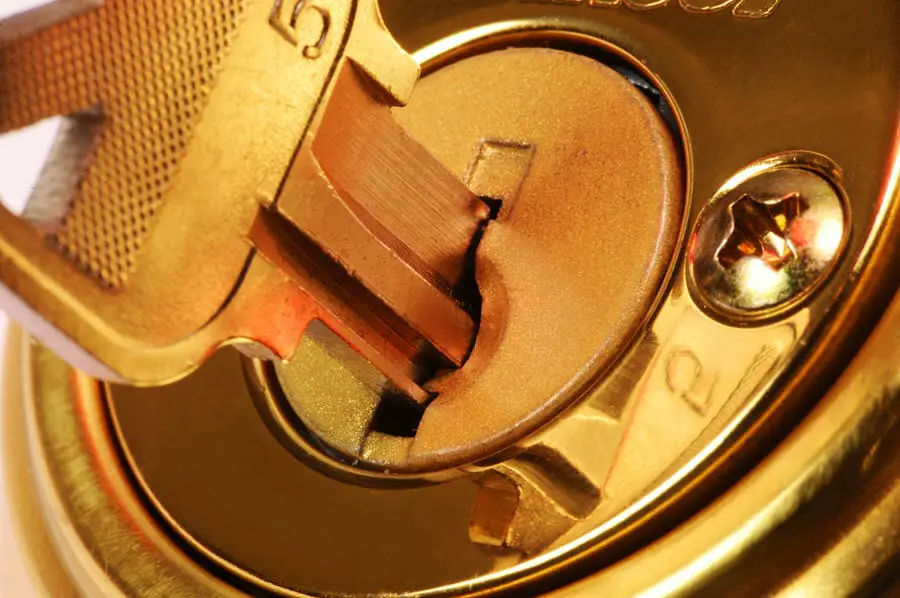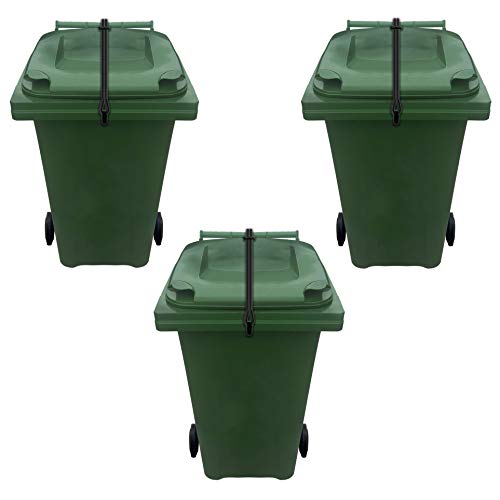Locks for wheelie bins are only ever bought by home owners that have fallen victim to anti social behaviour. The fact that you feel the need to search for wheelie bin locks shows just how irritating it is to have your bin tampered with, but are rubbish bin locks a good idea?
Contents
Wheelie Bin Lid Locks
A wheelie bin lock works in one of two ways. The first secures the lid closed with a locking mechanism. The second attaches the bin itself to a static object such as a wall of your house. These solutions prevent others placing items into your bin and removing your bin respectively.

In order to distinguish between the two types of locks, we’ll refer to them as lid locks and locking clamps. Lid locks are therefore the type the prevent unauthorised waste being placed in your bin by others, while locking clamps securely attach the bin to prevent its removal.
Finding your bin full of other people’s rubbish is more than just annoying, it can be a huge inconvenience. We all pay for our bin collections as part of our council tax, and rightly expect to get exclusive use of our wheelie bins to dispose of our household waste.
While technically it’s illegal to use someone else’s wheelie bin without permission and is considered fly tipping, like many other low level crimes, the police aren’t likely to invest a huge amount of time investigating who dumped their pizza box in your bin.
Wheelie bin lid locks are designed to prevent others from opening your bin, by fixing a locking mechanism between the lid of the bin and the main body. You’ll then need to release the lock with either a key or code number (like some bike locks) to lift the lid.
Here are some popular locks from Amazon:
Products From Amazon
As an Amazon Associate I earn from qualifying purchases.
| Image | Description |
|---|---|
 |
2-Pack Steel Rope Padlocks with Keys – Heavy-Duty Flexible Steel Cable Locks with Long Shackle for Indoor & Outdoor Use, Ideal for Bicycles, Gates, Wheelie Bins, Gym Lockers & Suitcases
|
 |
2 Pcs Steel Rope Padlocks with Keys and Heavy Duty Long Shackle Padlocks, Flexible Cable Padlock for Outdoor Indoor Wheelie Bin Bicycle Suitcase Gate Gym Locker Wire
|
 |
Decoralin Triangular Key for Lockable Wheelie Bins, Elevator Door, Fireplace, Chimney, Gas Meter Cabinet, Switch Control Cabinet, Long Handle – Black
|
Locking Clamps
Securing your bin in place can be achieved through the use of locking clamps. These are brackets fitted to the wall of your house (or other fixed location) with screws to gave a sturdy fixing point. The wheelie bin handles then lock into the clamp, again requiring a key or code to release.
Amazon also sell clamps if you’re looking to secure your bin in place:
Clamps From Amazon
As an Amazon Associate I earn from qualifying purchases.
| Image | Description |
|---|---|
 |
Wheelie Bin Buddy Storm Lock Secure Bin Clamp
|
 |
Wheelie Bin Lid Lock Strap – Heavy Duty – Windy Version – NO DRILLING, NO GLUEING – Secure Contents From Spilling – Stop Wind or Vandals Tipping – Easy Fitting (MULTI bin pack) (3)
|
 |
Wheelie Bin Lid Adjustable Securing Black Strap Clips Lock 120/240 Ltr Bin Wind Storm Animal Protection
|
The Pro’s And Con’s
These devices are very effective at doing their job, however, they also have a couple of downsides that you should be aware of before you decide to invest in one.
Disadvantages To Using A Lid Lock
Firstly, with the lid locks, while you are keeping other people from putting waste into your bin, you’re also making it a harder job for yourself to put your rubbish in.
Is A Lid Lock More Trouble Than It’s Worth?
Admittedly, putting a key into a lock and turning it to release is fairly straightforward. On the other hand, if you’re anything like me, you’ll find yourself from time to time with a bag splitting between the kitchen and the wheelie bin, so the last thing you want is an extra job to complete before the contents of a bag spill out all over the place.
The solution here is clearly to unlock the bin before taking the bag out, but that’s an extra journey, and hand on heart, I’m not someone who has the time or inclination to make chores harder than they already are. I’m not saying everyone is (lazy) like me, but it’s worth a moment’s thought before buying locks.
Will You Remember To Unlock The Bin For Collection?
A second and more important point is whether it will stop your bin getting emptied. Bin men tend not to be the most patient types, and they’re under pressure to keep moving. If you forget to unlock the bin lid before it goes out, it’s highly unlikely that the refuse collectors will stop to tell you – it’s a near certainty that your bin will not be emptied and stay full at the roadside while they move on to the next house.
Keys Going Walkies
Finally, there’s misplaced keys. While some models operate on number coded locks, the majority are key operated. Just like car keys, house keys and any other key that’s ever been created, the most common time for them to hide from you is when you’re in a hurry. In this case that’s going to be when you hear the bin men coming down the street and remember the bin’s not out yet.
Maybe you’re a very organised person that always knows where your keys are, but if you’ve ever found yourself hunting for a set of keys, this is going to be another one to lose!
Lid locks are designed to keep everyone but the key holder out of your bin, so if they work it means you’re not going to open the bin without a key. As a result, if it stops you getting your bin emptied, you may be in no worse situation than finding neighbours rubbish in the bin in the first place.
Disadvantages Of Bin Locking Clamps
With the clamps to stop your bin moving, there’s the same issue with lost keys, so we’ll not go over the same ground again there.
The Fixing Point Needs Installation
In order to be effective, a locking wheelie bin bracket has to be sturdy and well fixed to something solid. Whatever that solid thing is must be near impossible to move, so most likely that’s a house or garage wall.
You’re going to need to drill holes for mounting screws, and install the clamp mechanism so that it’s rigidly attached. That may or may not be appealing, but understanding that there’s a little installation needed is important before you buy.
Thieves And Vandals Are Persistent
As a rule of thumb, people trying to steal your wheelie bin probably aren’t going to give a damn about damaging it. In fact, some people take bins to set light to them, because that’s the kind of lovely souls they are. Why on earth anyone behaves like that is beyond me, but a lack of understanding on my part isn’t going to change the fact that it happens.
If someone is keen to steal your bin, whatever their motivation, they’re probably not going to worry too much about damaging the clamp or your wall either. The clamp might well be successful in preventing your bin from being stolen, but that might mean they make more of a mess than would have been the case if there was no clamp and your bin had been stolen.
Locks Can Be More Trouble Than They’re Worth
All of the above sounds a little negative, I know, but I wanted to really hammer the point home that you’re potentially going to try to put off thieves, but at the same time inconvenience yourself.
If you still feel you need to protect your bin, by all means go ahead. Do so in the knowledge that the alternative is accepting that while your bin might go missing from time to time.
A final point to consider is that in most cases you don’t technically own your bins. When councils provide you with your refuse bins, they are, in effect, loaning them to you. As a result, that means that you shouldn’t be modifying them or damaging them in any way.
Of course, the reason you want to get your hands on the lock in the first place is to keep them safe, so it could be argued that you’re protecting the council’s investment on their behalf. In reality though, if you phone and ask them, unlike house number stickers on your wheelie bin, they’ll likely say that they don’t advise the use of locks or outright tell you that they’re not allowed.
As the saying goes, it’s easier to gain forgiveness than permission, and I would say it’s unlikely that any council would pursue a resident for trying to keep their bin safe.
The bigger issue for me is that the cost of the locking mechanisms is likely to be nearly as much as a replacement bin if yours goes missing. If you are suffering from repeated bin thefts of vandalism, or have a neighbour that regularly fills your bin with rubbish, you might think differently to me!
